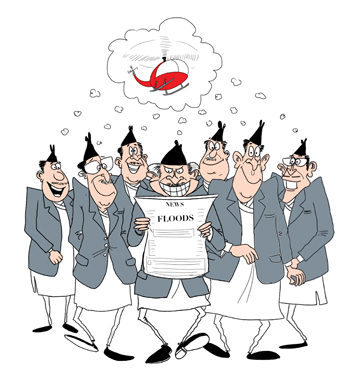Let’s not blame nature, the real disaster is the failure of governance that leads to lack of preparedness

DIWAKAR CHETTRI
It is the same old story every
monsoon season, only this year it started earlier than usual. Massive cloudbursts over western Nepal and the neighbouring Indian state of Uttarakhand in mid-June unleashed the total average monthly rainfall in a short span of 24 hours.
Every year, the downstream Indian states of Bihar and Uttar Pradesh blame Nepal for ‘releasing’ water. This time, it was Nepal that accused India of letting out water from the Dhauliganga Dam on a tributary of the Mahakali River that forms Nepal’s western border with India. Someone forgot that the Dhauliganga is a run-of-the-river scheme with daily pondage so it doesn’t store much.
It is the same blame game every rainy season: governments are blamed for lack of adequate and timely response, the Indians are blamed for building embankments, Biharis blame Nepal for letting water out from non-existent dams, climate change is blamed for our lack of preparedness, and everyone blames God for unleashing a ‘natural disaster’.
The rainfall this year was heavy, but it was hardly unprecedented. Northern India has historically suffered major floods, including the damming of the Alkananda in 1894 by a landslide and the bursting of the impounded lake which unleashed a wall of water that devastated the valleys below all the way down to Hardwar. The district capital of Darchula, Khalanga, itself is located on an elevated bank that is the relic of catastrophic floods on the Mahakali in historic times.
As with earthquakes, there is no point blaming God. Floods and earthquakes are a given in Nepal, the question is what have we done to mitigate loss of life and damage? These are not ‘natural’ disasters but man-made calamities because population pressure, greed, and corruption lead people to flout building codes and zoning laws.
The Himalaya is a fragile and geologically young range, prone to erosion and landslides in what is also the most densely-populated mountain region in the world. The combination of topography and climate make the Himalaya vulnerable to disasters.
Hazard mapping pinpoints where settlements can be relatively safe. Our forebears knew it was dangerous to live along floodplains and built homesteads on higher ground. Cloudbursts have always been a feature of the Asian summer monsoon, so settlements and infrastructure have to take these risks into account and heed nature’s repeated warnings.
The tragedy that struck Uttarakhand was made worse because it coincided with the pilgrimage season to the holy Hindu sites when thousands of Nepalis flock to northern Indian states either as pilgrims or porters. As it turned out, more Nepalis were killed in India than in Nepal itself.
There have been heroic rescues and miraculous tales of survival from India. Even the Indian state, with all the heavy-lift helicopters and a relatively better equipped disaster response setup at its disposal, found it difficult to cope with the sheer scale of the disaster. One shudders to think what would have happened had the Nepali side been hit harder.
Floods and landslides during the monsoon should not surprise anyone, what is surprising is our utter lack of preparedness, the ad hoc nature of the response, and the disaster tourism of our ‘cockpit netas’. As pressure on land forces people to settle on floodplains and climate change increases the intensity of extreme weather events, our response should be better early warning systems, and preparedness for rescue and relief.
Let’s not blame nature, the real disaster here is the failure of governance and the lack of political will not just to be prepared but to even provide the relief that is needed when disaster strikes.
Read also:
A flood of recrimination
Unnatural disaster
Himalayan Tsunami